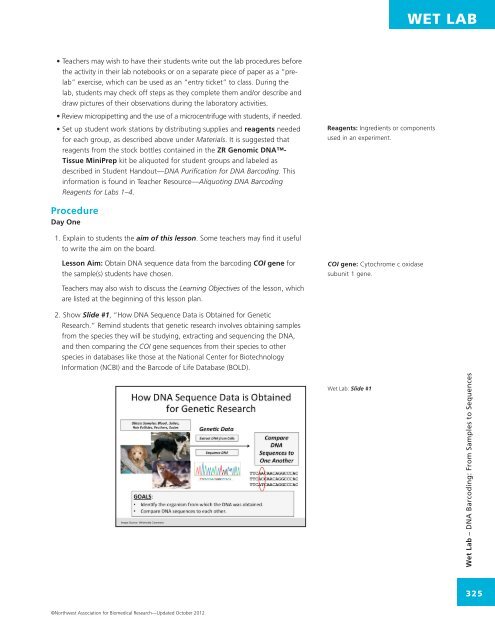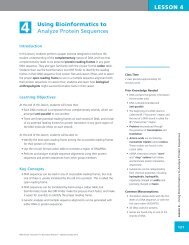WET LAB DNA Barcoding: From Samples to Sequences - Northwest ...
WET LAB DNA Barcoding: From Samples to Sequences - Northwest ...
WET LAB DNA Barcoding: From Samples to Sequences - Northwest ...
You also want an ePaper? Increase the reach of your titles
YUMPU automatically turns print PDFs into web optimized ePapers that Google loves.
<strong>WET</strong> <strong>LAB</strong><br />
• Teachers may wish <strong>to</strong> have their students write out the lab procedures before<br />
the activity in their lab notebooks or on a separate piece of paper as a “prelab”<br />
exercise, which can be used as an “entry ticket” <strong>to</strong> class. During the<br />
lab, students may check off steps as they complete them and/or describe and<br />
draw pictures of their observations during the labora<strong>to</strong>ry activities.<br />
• Review micropipetting and the use of a microcentrifuge with students, if needed.<br />
• Set up student work stations by distributing supplies and reagents needed<br />
for each group, as described above under Materials. It is suggested that<br />
reagents from the s<strong>to</strong>ck bottles contained in the ZR Genomic <strong>DNA</strong>-<br />
Tissue MiniPrep kit be aliquoted for student groups and labeled as<br />
described in Student Handout—<strong>DNA</strong> Purification for <strong>DNA</strong> <strong>Barcoding</strong>. This<br />
information is found in Teacher Resource—Aliquoting <strong>DNA</strong> <strong>Barcoding</strong><br />
Reagents for Labs 1–4.<br />
Reagents: Ingredients or components<br />
used in an experiment.<br />
Procedure<br />
Day One<br />
1. Explain <strong>to</strong> students the aim of this lesson. Some teachers may find it useful<br />
<strong>to</strong> write the aim on the board.<br />
Lesson Aim: Obtain <strong>DNA</strong> sequence data from the barcoding COI gene for<br />
the sample(s) students have chosen.<br />
COI gene: Cy<strong>to</strong>chrome c oxidase<br />
subunit 1 gene.<br />
Teachers may also wish <strong>to</strong> discuss the Learning Objectives of the lesson, which<br />
are listed at the beginning of this lesson plan.<br />
2. Show Slide #1, “How <strong>DNA</strong> Sequence Data is Obtained for Genetic<br />
Research.” Remind students that genetic research involves obtaining samples<br />
from the species they will be studying, extracting and sequencing the <strong>DNA</strong>,<br />
and then comparing the COI gene sequences from their species <strong>to</strong> other<br />
species in databases like those at the National Center for Biotechnology<br />
Information (NCBI) and the Barcode of Life Database (BOLD).<br />
Wet Lab: Slide #1<br />
Wet Lab – <strong>DNA</strong> <strong>Barcoding</strong>: <strong>From</strong> <strong>Samples</strong> <strong>to</strong> <strong>Sequences</strong><br />
325<br />
©<strong>Northwest</strong> Association for Biomedical Research—Updated Oc<strong>to</strong>ber 2012
















